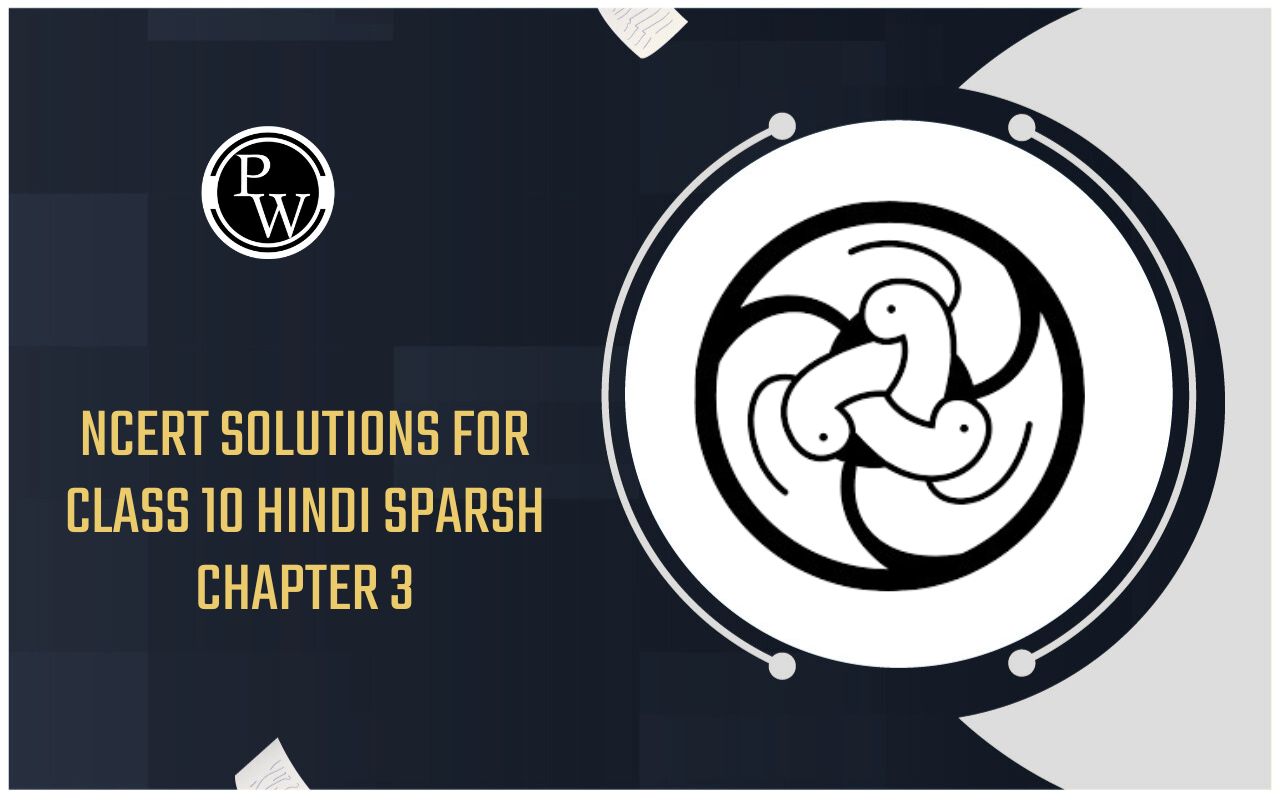
NCERT Solutions for Class 10 Science Chapter 13: Chapter 13 of the NCERT Class 10 Science textbook is about how electric current creates magnetic fields and how these fields affect different materials. The chapter explains the magnetic field around a wire that carries current, how electromagnets work, and the basics of electric motors and generators.
It also looks at how these ideas are used in everyday devices. The NCERT solutions for this chapter offer clear explanations and step-by-step answers to the exercises, helping students understand the concepts and prepare well for their exams.NCERT Solutions for Class 10 Science Chapter 13 Magnetic Effects of Electric Current Overview
The NCERT Solutions for Class 10 Science Chapter 13 Magnetic Effects of Electric Current are created by subject experts of Physics Wallah. These solutions provide a detailed overview of the chapter, focusing on the fundamental concepts such as the generation of magnetic fields by electric currents, the functioning of electromagnets, and the principles behind electric motors and generators. With step-by-step explanations and detailed answers to the textbook exercises these solutions are designed to enhance students understanding and help them in their exams.NCERT Solutions for Class 10 Science Chapter 13 Magnetic PDF
For students seeking a detailed understanding of Magnetic Effects of Electric Current the NCERT Solutions for Class 10 Science Chapter 13 are available in a PDF format. This PDF includes expert-prepared solutions from Physics Wallah, covering all the key concepts and questions from the chapter. To access these valuable resources and improve your grasp of the subject you can download the PDF using the link provided below:NCERT Solutions for Class 10 Science Chapter 13 Magnetic Effects of Electric Current PDF
NCERT Solutions for Class 10 Science Chapter 13 Magnetic Effects of Electric Current
Here, we have provided NCERT Solutions for Class 10 Science Chapter 13 to help students prepare more effectively for their exams.NCERT Solutions for Class 10 Science Chapter 13 Exercise Page:224
1. Why does a compass needle get deflected when brought near a bar magnet?
Solution:
When a compass needle is brought near a bar magnet, it gets deflected due to the interaction between the magnetic fields. The compass needle itself is a small magnet with its own magnetic field. When it is close to the bar magnet, the magnetic field of the bar magnet exerts a force on the compass needle. This force causes the needle to align with the magnetic field of the bar magnet, leading to its deflection. The degree of deflection indicates the strength and direction of the magnetic field created by the bar magnet.NCERT Solutions for Class 10 Science Chapter 13 Magnetic Effects of Electric Current Page:228
1. Draw magnetic field lines around a bar magnet.
Solution:
Magnetic field lines of a bar magnet always emerge from the North Pole and curve around to enter the South Pole. This pattern forms a closed loop around the magnet. When the compass needle is brought near the bar magnet, it aligns with these magnetic field lines, causing it to deflect. The direction and strength of the deflection provide information about the magnetic field's direction and intensity around the magnet.
2. List the properties of magnetic field lines.
Solution:
The properties of magnetic field lines are as follows:- Magnetic field lines do not intersect each other; if they did, it would imply two different directions for the magnetic field at the point of intersection, which is not possible.
- Magnetic field lines emerge from the North Pole of a magnet and terminate at the South Pole, creating a continuous loop.
- Inside the magnet, the direction of the field lines is from the South Pole to the North Pole, completing the loop of the magnetic field.
3. Why don’t two magnetic field lines intersect each other?
Solution:
Two magnetic field lines do not intersect because if they did, it would imply that at the point of intersection, the compass needle would point in two different directions simultaneously. This is not possible as a magnetic field has only one direction at any given point. Thus, to maintain a consistent direction of the magnetic field, the field lines do not cross each other.NCERT Solutions for Class 10 Science Chapter 13 Exercise Page:229
1. Consider a circular loop of wire lying in the plane of the table. Let the current pass through the loop clockwise. Apply the right-hand rule to find out the direction of the magnetic field inside and outside the loop.
Solution:
 For a current flowing in a loop, the direction of the magnetic field depends on the direction of the current. If the current flows downward through the loop, the magnetic field will appear to emerge from the table surface outside the loop and merge with the table surface inside the loop.
Conversely, if the current flows upward, the magnetic field will appear to emerge from the table surface inside the loop and merge with the table surface outside the loop. This directionality of the magnetic field follows the right-hand rule, which is used to determine the orientation of the magnetic field around a current-carrying loop.
For a current flowing in a loop, the direction of the magnetic field depends on the direction of the current. If the current flows downward through the loop, the magnetic field will appear to emerge from the table surface outside the loop and merge with the table surface inside the loop.
Conversely, if the current flows upward, the magnetic field will appear to emerge from the table surface inside the loop and merge with the table surface outside the loop. This directionality of the magnetic field follows the right-hand rule, which is used to determine the orientation of the magnetic field around a current-carrying loop.
2. The magnetic field in a given region is uniform. Draw a diagram to represent it.
Solution:

3. Choose the correct option.
The magnetic field inside a long straight solenoid-carrying current
- is zero.
- decreases as we move towards its end.
- increases as we move towards its end.
- is the same at all points.
Solution:
d. is the same at all pointsNCERT Solutions for Class 10 Science Chapter 13 Magnetic Effects of Electric Current Page:231
1. Which of the following property of a proton can change while it moves freely in a magnetic field? (There may be more than one correct answer.)
- Mass
- Speed
- Velocity
- Momentum
Solution:
(c) and (d)2. In Activity 13.7, how do we think the displacement of rod AB will be affected if (i) current in rod AB is increased; (ii) a stronger horse-shoe magnet is used; and (iii) length of the rod AB is increased?
Solution:
When a current-carrying conductor, such as rod AB, is placed in a magnetic field, it experiences a force due to the interaction between the current and the magnetic field. The magnitude of this force depends on several factors, and it will increase if:- The current in rod AB is increased : The force experienced by the rod is directly proportional to the amount of current flowing through it. Hence, increasing the current will increase the magnetic force exerted on the rod.
- A stronger horseshoe magnet is used : The force is also directly proportional to the strength of the magnetic field. Using a stronger magnet will increase the strength of the magnetic field, thereby increasing the force on the rod.
- When the length of the rod AB increases : The force is directly proportional to the length of the conductor within the magnetic field. Therefore, increasing the length of the rod will increase the force exerted on it.
3. A positively-charged particle (alpha-particle) projected towards the west is deflected towards north by a magnetic field. The direction of magnetic field is
- towards south
- towards east
- downward
- upward
Solution:
The direction of the magnetic field can be determined using Fleming’s Left-hand Rule. According to this rule, if you arrange your thumb, forefinger, and middle finger of your left hand perpendicular to each other:- Thumb points in the direction of the magnetic force.
- Forefinger points in the direction of the magnetic field.
- Middle finger points in the direction of the current.
NCERT Solutions for Class 10 Science Chapter 13 Magnetic Effects of Electric Current Page:233
1. State Fleming’s left-hand rule.
Solution:
Fleming’s Left-hand Rule states that if you arrange the thumb, forefinger, and middle finger of your left hand at right angles to each other, then:- Thumb points in the direction of the magnetic force.
- Forefinger points in the direction of the magnetic field.
- Middle finger points in the direction of the current.
2. What is the principle of an electric motor?
Solution:
The working principle of an electric motor is based on the magnetic effect of current. When a current-carrying conductor is placed in a magnetic field, it experiences a force that causes it to rotate. The direction of this rotation can be determined using Fleming’s Left-hand Rule. According to the rule:- The thumb points in the direction of the force.
- The forefinger points in the direction of the magnetic field.
- The middle finger points in the direction of the current.
3. What is the role of split ring in an electric motor?
Solution:
The split ring in an electric motor acts as a commutator. Its primary function is to reverse the direction of the current flowing through the coil after each half-rotation. This reversal ensures that the force acting on the coil is always in the same direction, allowing the coil to continue rotating smoothly and consistently.NCERT Solutions for Class 10 Science Chapter 13 Page:236
1. Explain different ways to induce current in a coil.
Solution:
Here are different ways to induce a current in a coil:- Moving the coil rapidly between the two poles of a horseshoe magnet induces an electric current in the coil.
- Moving a magnet relative to the coil also induces an electric current in the coil.
NCERT Solutions for Class 10 Science Chapter 13 Magnetic Effects of Electric Current Page:237
1. State the principle of an electric generator.
Solution: An electric generator works on the principle of electromagnetic induction. In a generator, electricity is produced by rotating a coil within a magnetic field. This rotation causes a change in the magnetic flux through the coil, which induces an electric current according to Faraday's law of induction.2. Name some sources of direct current.
Solution: Cells and DC generators are some sources of direct current.3. Which sources produce alternating current?
Solution: AC generators and Power plants are some of the sources that produce alternating current.4. Choose the correct option.
A rectangular coil of copper wires is rotated in a magnetic field. The direction of the induced current changes once in each
- two revolutions
- one revolution
- half revolution
- one-fourth revolution
NCERT Solutions for Class 10 Science Chapter 13 Magnetic Effects of Electric Current Page:238
1. Name two safety measures commonly used in electric circuits and appliances.
Solution:Fuse
Each circuit should be connected to a fuse because it prevents the flow of excessive current. When the current exceeds the fuse's maximum limit, the fuse melts, stopping the current flow and protecting the connected appliance.Earthing
Earthing protects users from electric shocks. It transfers any leakage of current in an appliance to the ground, thereby preventing electric shocks and ensuring user safety.2. An electric oven of 2 kW power rating is operated in a domestic electric circuit (220 V) that has a current rating of 5 A. What result do you expect? Explain.
Solution: The current drawn by the electric oven can be calculated using the formula P = V × I I = P/V Substituting the values, we get I = 2000 W/220 V = 9.09 A The current drawn by the electric oven is 9.09 A which exceeds the safe limit of the circuit. This causes the fuse to melt and break the circuit.3 . What precaution should be taken to avoid the overloading of domestic electric circuits?
Solution:To avoid overloading domestic electric circuits, consider the following precautions:
- Avoid Connecting Too Many Devices to a Single Socket: Plugging multiple devices into one socket can overload the circuit and increase the risk of overheating and fires.
- Avoid Using Too Many Appliances Simultaneously: Operating many high-power appliances at the same time can exceed the circuit's capacity, leading to overloading and potential damage.
- Do Not Connect Faulty Appliances: Faulty or damaged appliances should not be plugged in, as they can cause short circuits and increase the risk of electrical hazards.
NCERT Solutions for Class 10 Science Chapter 13 Page:240
1. Which of the following correctly describes the magnetic field near a long straight wire?
- The field consists of straight lines perpendicular to the wire.
- The field consists of straight lines parallel to the wire.
- The field consists of radial lines originating from the wire.
- The field consists of concentric circles centered on the wire.
2. The phenomenon of electromagnetic induction is
- the process of charging a body.
- the process of generating a magnetic field due to a current passing through a coil.
- producing induced current in a coil due to relative motion between a magnet and the coil.
- the process of rotating a coil of an electric motor.
3. The device used for producing electric current is called a
- generator
- galvanometer
- ammeter
- motor
4. The essential difference between an AC generator and a DC generator is that
- AC generator has an electromagnet while a DC generator has permanent magnet.
- DC generator will generate a higher voltage.
- AC generator will generate a higher voltage.
- AC generator has slip rings while the DC generator has a commutator.
5. At the time of short circuit, the current in the circuit
- reduces substantially.
- does not change.
- increases heavily.
- vary continuously.
6. State whether the following statements are true or false.
- An electric motor converts mechanical energy into electrical energy.
- An electric generator works on the principle of electromagnetic induction.
- The field at the center of a long circular coil carrying current will be parallel straight lines.
- A wire with a green insulation is usually the live wire of an electric supply.
7. List two methods of producing magnetic fields.
Solution:Using a Permanent Magnet: A magnetic field can be produced by a permanent magnet. This field is visible by spreading iron filings on a white sheet of paper and placing the magnet underneath. The iron filings align along the magnetic field lines, showing the shape and direction of the field.
Current-Carrying Straight Conductor: A magnetic field is generated around a straight conductor when an electric current passes through it. The direction and shape of the magnetic field can be observed using a compass or iron filings.
Solenoids and Circular Loops: Different types of conductors, such as solenoids (coils of wire) and circular loops, can also produce magnetic fields. By passing current through these conductors, the resulting magnetic field can be visualized and measured, demonstrating how the field is concentrated within and around the coil or loop.
8. How does a solenoid behave like a magnet? Can you determine the north and south poles of a current–carrying solenoid with the help of a bar magnet? Explain.
Solution: A solenoid is a long coil made of circular loops of insulated copper wire. When an electric current flows through the solenoid, it generates a magnetic field similar to that of a bar magnet. The magnetic field lines around the solenoid form closed loops, resembling those around a bar magnet, with distinct north and south poles. The field inside the solenoid is strong and uniform, while the field outside curves around from one pole to the other. The arrangement of these magnetic fields can be visualized using iron filings or a magnetic field sensor, as shown in the figure below. When the north pole of a bar magnet is brought close to the end of a solenoid connected to the negative terminal of a battery, the solenoid experiences a repulsive force. This repulsion occurs because like poles repel each other. From this observation, we can infer that the end of the solenoid connected to the negative terminal of the battery behaves as a north pole, while the end connected to the positive terminal acts as a south pole.
When the north pole of a bar magnet is brought close to the end of a solenoid connected to the negative terminal of a battery, the solenoid experiences a repulsive force. This repulsion occurs because like poles repel each other. From this observation, we can infer that the end of the solenoid connected to the negative terminal of the battery behaves as a north pole, while the end connected to the positive terminal acts as a south pole.
9. When is the force experienced by a current–carrying conductor placed in a magnetic field largest?
Solution: When the direction of the current is perpendicular to the direction of the magnetic field, the force experienced by the conductor is at its maximum.10. Imagine that you are sitting in a chamber with your back to one wall. An electron beam, moving horizontally from back wall towards the front wall, is deflected by a strong magnetic field to your right side. What is the direction of magnetic field?
Solution: The direction of the magnetic field can be determined using Fleming’s Left-Hand Rule. According to this rule, if we arrange our thumb, forefinger, and middle finger of the left hand perpendicular to each other, the thumb indicates the direction of the magnetic force, the middle finger shows the direction of the current, and the forefinger points in the direction of the magnetic field. In this case, the current flows from the front wall to the back wall of the chamber, which means negatively charged electrons move in the opposite direction, from the back wall to the front wall. Given that the magnetic force is directed rightward, and the direction of the current is perpendicular to this force, Fleming’s Left-Hand Rule reveals that the magnetic field direction inside the chamber is downward.11. Draw a labelled diagram of an electric motor. Explain its principle and working. What is the function of a split ring in an electric motor?
Solution: An electric motor is a device that transforms electrical energy into mechanical energy, operating on the principle of the magnetic effect of current. In a basic electric motor, when current flows through the coil MNST by closing the switch, the coil begins to rotate in an anticlockwise direction. This rotation is due to the forces acting on the coil: a downward force on the length MN and an upward force on the length ST. The current flows from M to N in the length MN, with the magnetic field oriented from left to right. According to Fleming’s Left-Hand Rule, this setup produces a downward force on MN. Similarly, for the length ST, the current flows from S to T with the magnetic field still oriented from left to right, resulting in an upward force on ST. These opposing forces cause the coil to rotate anticlockwise. After half a rotation, the positions of MN and ST switch. The half-ring C contacts brush B, and the half-ring D contacts brush C, reversing the direction of current in the coil MNST. This reversal of current ensures continuous rotation of the coil in the same direction.
12. Name some devices in which electric motors are used.
Solution: A few devices in which electric motors are used are:- Electric fans
- Mixers
- Washing machines
- Water pumps
13. A coil of insulated copper wire is connected to a galvanometer. What will happen if a bar magnet is (i) pushed into the coil, (ii) withdrawn from inside the coil, (iii) held stationary inside the coil?
Solution:14. Two circular coils A and B are placed closed to each other. If the current in the coil A is changed, will some current be induced in the coil B? Give reason.
Solution: When the current in coil A changes, the magnetic field around it also changes. This varying magnetic field affects coil B, which is placed nearby. The change in the magnetic field experienced by coil B induces a current in it through the process of electromagnetic induction. This phenomenon occurs because a changing magnetic field creates an electromotive force (EMF) in coil B, leading to the flow of current.15. State the rule to determine the direction of a (i) magnetic field produced around a straight conductor-carrying current, (ii) force experienced by a current-carrying straight conductor placed in a magnetic field which is perpendicular to it, and (iii) current induced in a coil due to its rotation in a magnetic field.
Solution: (i) The rule used to determine the direction of the magnetic field produced around a straight conductor carrying current is Maxwell’s right-hand thumb rule . According to this rule, if you point your thumb in the direction of the current, your curled fingers show the direction of the magnetic field lines around the conductor. (ii) The rule used to determine the force experienced by a current-carrying straight conductor placed in a magnetic field that is perpendicular to it is Fleming’s left-hand rule . This rule helps to find the direction of the force acting on the conductor, where the thumb represents the force, the forefinger represents the magnetic field, and the middle finger represents the current. (iii) The rule used to determine the current induced in a coil due to its rotation in a magnetic field is Fleming’s right-hand rule . This rule indicates the direction of the induced current when a conductor moves in a magnetic field, where the thumb points in the direction of the motion of the conductor, the forefinger in the direction of the magnetic field, and the middle finger shows the direction of the induced current.16. Explain the underlying principle and working of an electric generator by drawing a labelled diagram. What is the function of brushes?
Solution: The electric generator transforms mechanical energy into electrical energy through the principle of electromagnetic induction. This process involves rotating a coil within a magnetic field to generate electricity. In a simple AC generator, the key components include brushes, slip rings, an axle, and a galvanometer. Here’s how it works:- A and B are brushes that make contact with the C and D slip rings, which are attached to the rotating coil.
- X represents the axle around which the coil rotates.
- G is the galvanometer that measures the induced current.
Function of Brushes: Brushes press against the slip rings, transferring the generated current from the rotating coil to the external circuit, and thus play a crucial role in the functioning of the generator.

17. What is the function of an earth wire? Why is it necessary to earth metallic appliances?
Solution: The metallic body of electric appliances is earthed using an earth wire to enhance safety. If there is any leakage of electricity from the appliance, the earth wire safely transfers this unwanted current to the ground. This grounding process prevents the user from receiving electric shocks, thus protecting against potential electrical hazards. Proper earthing is crucial for ensuring the safety of metallic appliances and reducing the risk of electrical accidents.Benefits of NCERT Solutions for Class 10 Science Chapter 13 Magnetic Effects of Electric Current
- Clear Understanding of Concepts : The solutions break down complex concepts like magnetic fields, electromagnetic induction, and Fleming's rules into simpler, easy-to-understand explanations.
- Step-by-Step Solutions : Each problem is solved step-by-step helping students grasp the methodology and reasoning behind each solution, which improves their problem-solving skills.
- Practice for Exams : The solutions provide a detailed set of practice problems that align with the NCERT syllabus, helping students prepare effectively for their exams.
- Concept Reinforcement : By solving these problems students reinforce their understanding of key concepts, ensuring they are well-prepared for both theoretical and practical questions.
- Error Correction : The solutions help identify and correct common mistakes, guiding students to avoid errors in their own work.
- Time Management : With well-structured solutions, students learn how to manage their time efficiently while solving exam questions, a crucial skill for completing exams within the allotted time.
NCERT Solutions for Class 10 Science Chapter 13 FAQs
What are magnetic field lines?
How does a current-carrying conductor create a magnetic field?
What is Fleming’s Left-Hand Rule?
What is the difference between AC and DC current?
How does a solenoid produce a magnetic field?










